Petra’s stunning rock-cut architecture and rich Nabatean culture offer unique insights for photographers. This article explores the intricate designs of Petra’s structures, the cultural significance of Nabatean art, and effective photography techniques. It also addresses challenges faced by photographers in capturing this UNESCO World Heritage Site. Through these perspectives, readers will gain a deeper appreciation for Petra’s historical and artistic legacy.
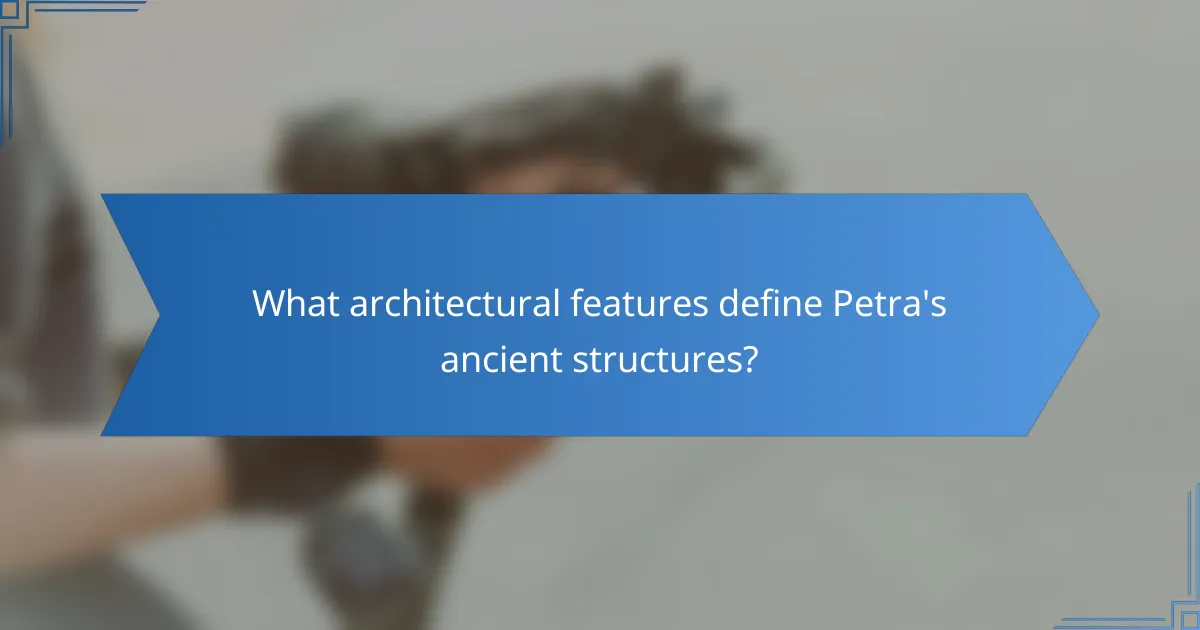
What architectural features define Petra’s ancient structures?
Petra’s ancient structures are defined by intricate rock-cut architecture, elaborate facades, and advanced water management systems. The most notable features include the Treasury with its Hellenistic influences, the Monastery showcasing monumental scale, and the extensive use of Nabatean decorative motifs. These attributes highlight the unique blend of local and foreign architectural styles in a desert environment. The site’s engineering prowess is evident in its sophisticated aqueducts and cisterns, essential for sustaining life and trade in ancient times.
How do rock-cut facades contribute to Petra’s aesthetic appeal?
Rock-cut facades enhance Petra’s aesthetic appeal through their intricate designs and vibrant colors. These facades showcase the Nabateans’ advanced craftsmanship and artistic vision. The natural stone’s hues, ranging from pink to red, create a striking visual contrast against the desert landscape. Additionally, the architectural elements, such as columns and carvings, reflect cultural influences, adding depth to the site’s historical narrative. This unique integration of natural and man-made beauty makes Petra a captivating subject for photography and exploration.
Which engineering techniques were employed by the Nabateans?
The Nabateans employed advanced engineering techniques, including rock-cut architecture, water management systems, and intricate road networks. They carved structures directly into sandstone cliffs, showcasing their mastery of stonework. Their water systems included cisterns and channels, allowing them to thrive in arid environments.
What role did water management systems play in Petra’s sustainability?
Water management systems were crucial for Petra’s sustainability, enabling efficient water collection and storage. These systems included cisterns, aqueducts, and channels that harnessed seasonal rainfall. As a result, they supported agriculture and daily life in a desert environment, ensuring the city’s growth and prosperity. The Nabateans’ innovative techniques allowed them to thrive in arid conditions, showcasing their engineering prowess and deep understanding of hydrology.
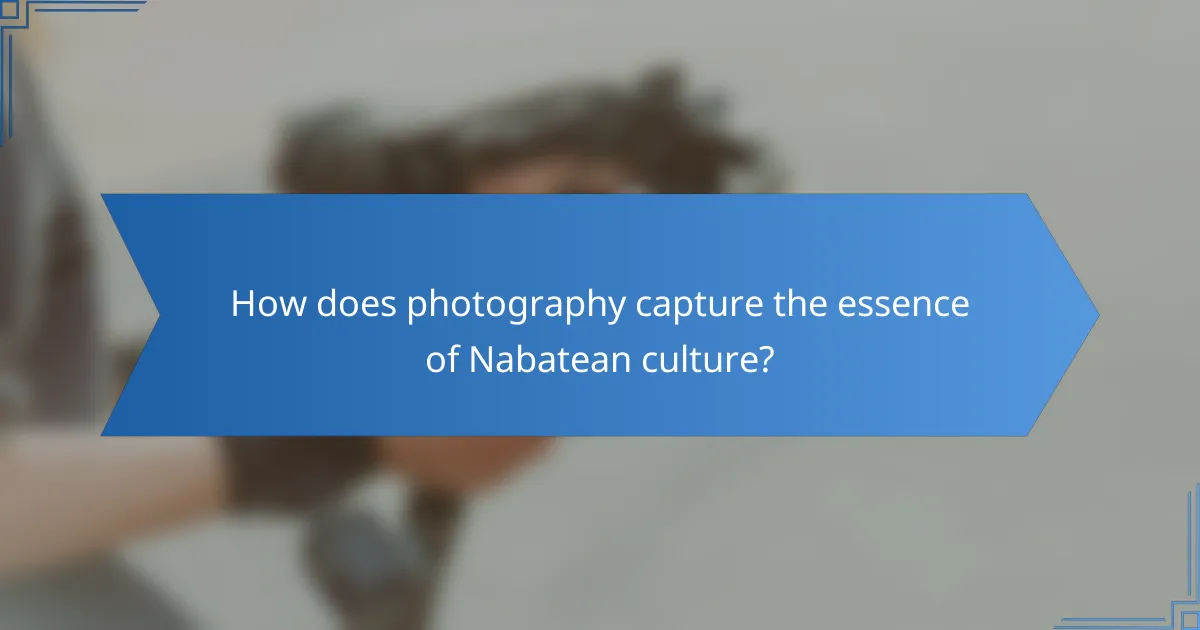
How does photography capture the essence of Nabatean culture?
Photography captures the essence of Nabatean culture by showcasing its intricate architecture and artistic details. The stunning rock-cut structures, such as Al-Khazneh, reflect the advanced engineering and aesthetic sensibilities of the Nabateans. Through images, viewers can appreciate the unique blend of Hellenistic and Eastern influences that define Nabatean art. Additionally, photography highlights the cultural significance of Petra as a trading hub, illustrating the lifestyle and traditions of its ancient inhabitants. This visual storytelling preserves the legacy of Nabatean civilization for future generations.
Which photographic techniques best showcase Petra’s architecture?
Wide-angle photography, low-angle shots, and golden hour lighting best showcase Petra’s architecture. These techniques highlight the intricate details and grandeur of the Nabatean structures.
Wide-angle lenses capture expansive views of Petra’s rock formations, emphasizing scale. Low-angle shots create a dramatic perspective, showcasing towering facades against the sky. Golden hour lighting enhances colors and textures, adding warmth to the stone surfaces.
Combining these techniques allows photographers to convey the majesty of Petra while capturing the unique attributes of its ancient architecture.
How can light and shadow enhance the visual storytelling of Petra?
Light and shadow significantly enhance the visual storytelling of Petra by creating depth and highlighting architectural details. The interplay of sunlight and shadow accentuates the intricate carvings and textures of the rock-cut facades, revealing the craftsmanship of Nabatean culture. During different times of the day, the changing light conditions produce dynamic contrasts, evoking emotions and setting the mood for each photograph. This visual drama not only captures the grandeur of Petra but also tells a story of its historical significance and cultural richness.
What cultural symbols are prevalent in Nabatean art and architecture?
Nabatean art and architecture prominently feature symbols such as water, nature, and trade. These elements reflect the Nabateans’ reliance on water management and their role as traders. The intricate rock-cut facades of Petra often depict motifs inspired by local flora and fauna, emphasizing their connection to the environment. Additionally, the use of elaborate tombs symbolizes the Nabatean beliefs in the afterlife and ancestral veneration.
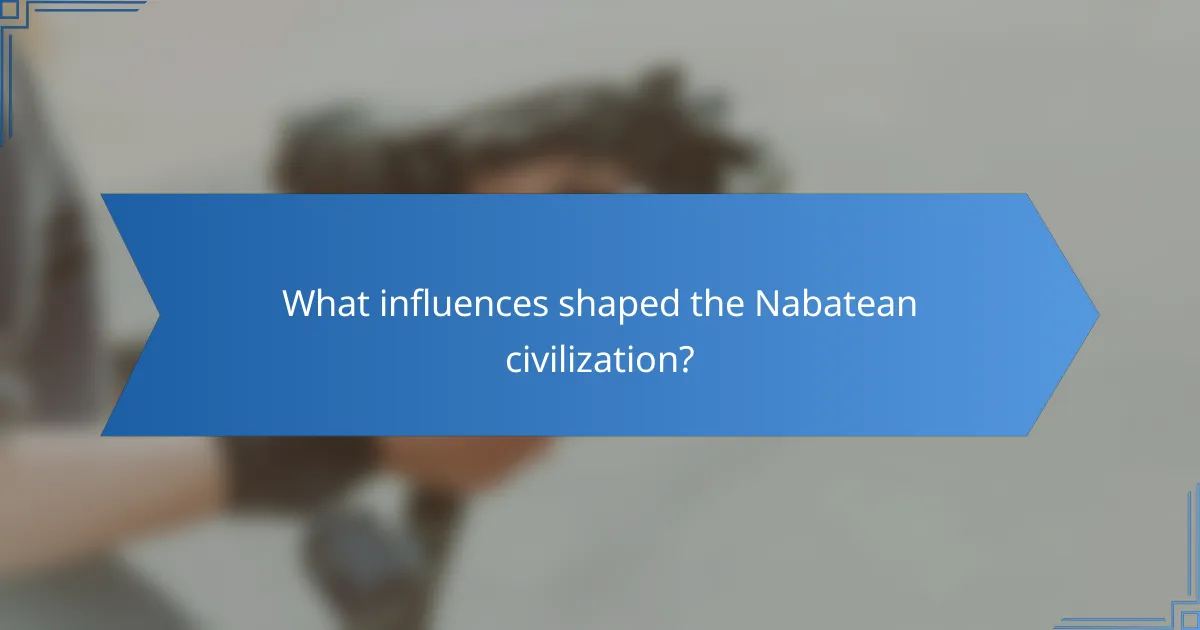
What influences shaped the Nabatean civilization?
The Nabatean civilization was shaped by trade routes, cultural exchanges, and geographical factors. Their strategic location along caravan paths facilitated commerce, leading to wealth and cultural diversity. The Nabateans adopted influences from surrounding cultures, notably Hellenistic and Arab, evident in their architecture and art. Their unique water conservation techniques allowed them to thrive in arid environments, showcasing their adaptability and innovation.
How did trade routes impact Petra’s development?
Trade routes significantly influenced Petra’s development by establishing it as a vital trading hub. The city’s strategic location along major caravan routes facilitated commerce between the Arabian Peninsula, Egypt, and the Mediterranean. This connectivity enabled Petra to thrive economically, attracting diverse cultures and boosting Nabatean wealth. As a result, the architecture of Petra reflects a blend of influences, showcasing unique attributes like intricate rock-cut facades and advanced water management systems. The prosperity from trade routes allowed the Nabateans to invest in monumental structures, enhancing Petra’s status as a cultural and commercial center in the ancient world.
Which neighboring cultures interacted with the Nabateans?
The Nabateans interacted with several neighboring cultures, notably the Arabs, Greeks, and Romans. These interactions influenced their trade, architecture, and artistic expressions. The Nabateans adopted elements from these cultures while maintaining their unique identity, evident in Petra’s architecture. Their trade routes facilitated cultural exchanges, enriching Nabatean society with diverse influences.
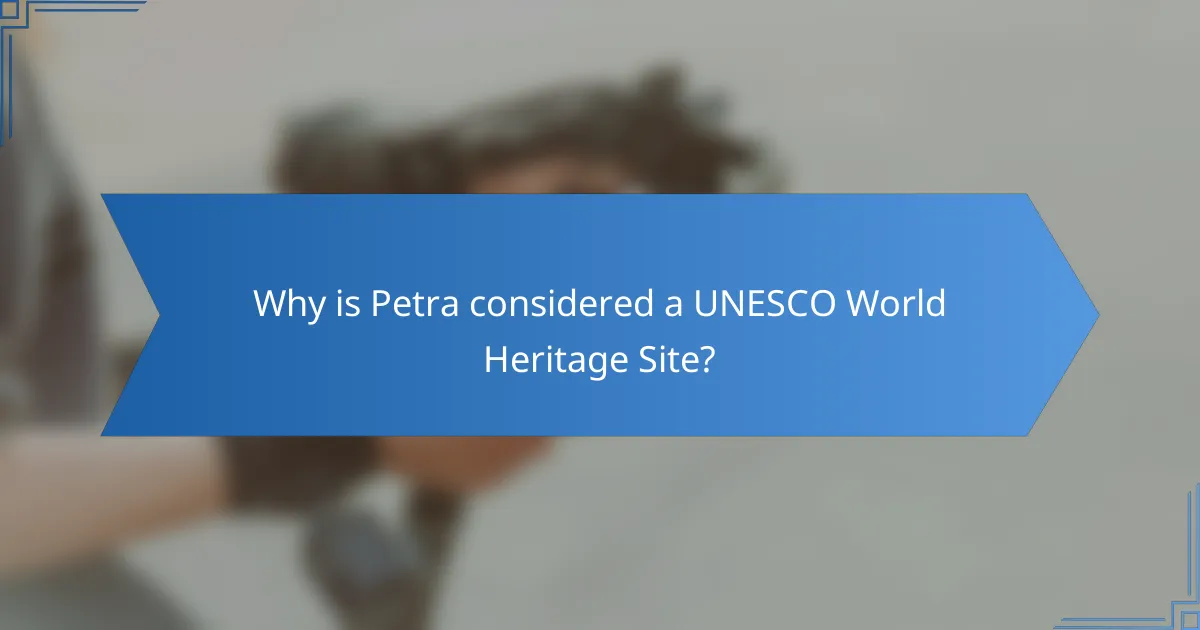
Why is Petra considered a UNESCO World Heritage Site?
Petra is considered a UNESCO World Heritage Site due to its unique archaeological significance and cultural heritage. The site showcases remarkable rock-cut architecture and water conduit systems developed by the Nabateans. Recognized in 1985, Petra represents a blend of Eastern and Western cultural influences, making it an exceptional example of ancient civilization. Its intricate carvings and monumental structures, such as Al-Khazneh, highlight the advanced engineering skills of the Nabateans. The preservation of Petra’s historical elements contributes to its status as a vital cultural landmark.
What criteria contributed to Petra’s designation as a cultural landmark?
Petra was designated as a cultural landmark due to its unique architectural style, historical significance, and the preservation of Nabatean culture. The rock-cut architecture showcases advanced engineering techniques, while the site’s role as a trade hub highlights its historical importance. Additionally, Petra’s inscriptions and artifacts provide insight into the Nabatean civilization, making it a valuable cultural heritage site.
How does preservation of Petra’s architecture affect tourism?
Preserving Petra’s architecture significantly enhances tourism by maintaining its historical integrity and attracting visitors. The well-preserved structures, such as the Treasury and Monastery, showcase Nabatean craftsmanship. This preservation fosters educational opportunities, allowing tourists to engage deeply with ancient culture. In 2022, Petra attracted over 1 million visitors, highlighting its global appeal. Sustainable tourism practices further ensure that these architectural wonders remain intact for future generations.
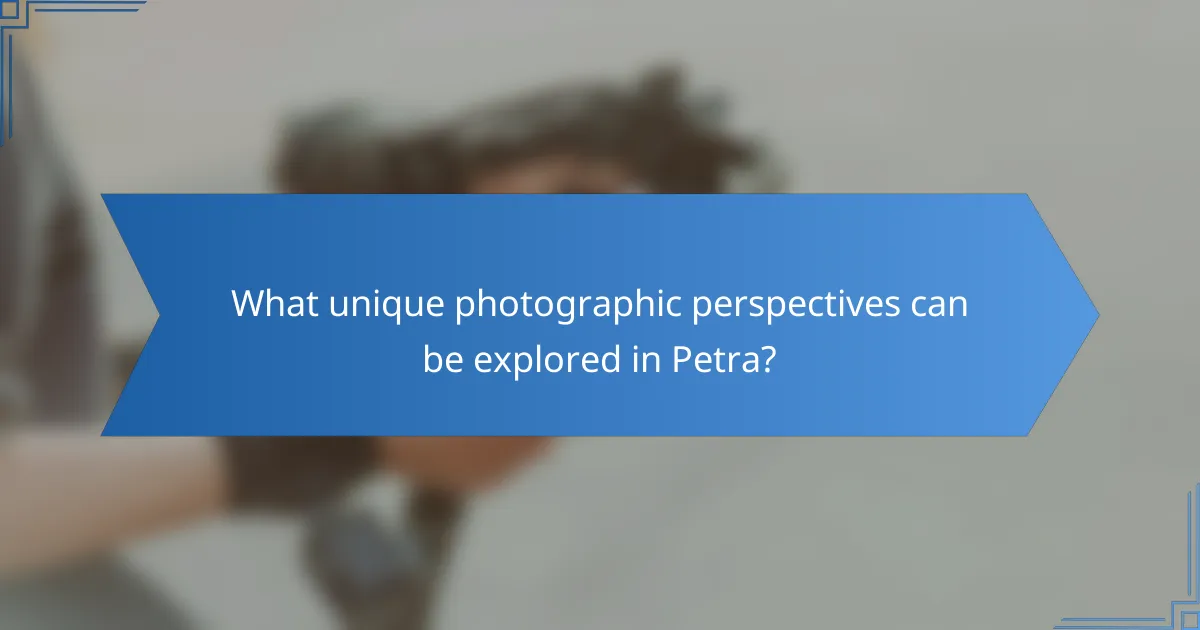
What unique photographic perspectives can be explored in Petra?
Petra offers unique photographic perspectives through its intricate rock-cut architecture and stunning landscapes. Capture the vibrant colors of the sandstone cliffs during sunrise or sunset for dramatic effects. Explore the narrow Siq, the main entrance, to photograph the contrasting light and shadows. Focus on the ornate facades of the Treasury and Monastery, showcasing Nabatean artistry. Utilize wide-angle lenses to emphasize the scale of the structures against the surrounding desert. Experiment with different angles, such as low shots to capture the towering cliffs, or high vantage points for panoramic views.
How do aerial shots transform the perception of Petra’s landscape?
Aerial shots significantly enhance the perception of Petra’s landscape by revealing its vastness and intricate topography. These perspectives highlight the unique rock formations and ancient structures, showcasing the architectural prowess of the Nabateans. The bird’s-eye view emphasizes the strategic location of Petra, nestled between towering cliffs, and illustrates the interplay of natural and man-made elements. This visual transformation invites deeper appreciation for the site’s historical significance and cultural heritage.
Which lesser-known sites within Petra offer unique photographic opportunities?
Petra features several lesser-known sites that provide unique photographic opportunities. Al-Beidha, also known as Little Petra, showcases intricate rock carvings and ancient tombs. The High Place of Sacrifice offers stunning panoramic views of the surrounding landscape. The Royal Tombs present elaborate facades, ideal for capturing architectural details. The Siq al-Barid, or the ‘Cold Siq,’ features beautiful sandstone formations and lesser-visited structures. Each of these locations highlights the Nabatean culture and enhances the photographic experience in Petra.
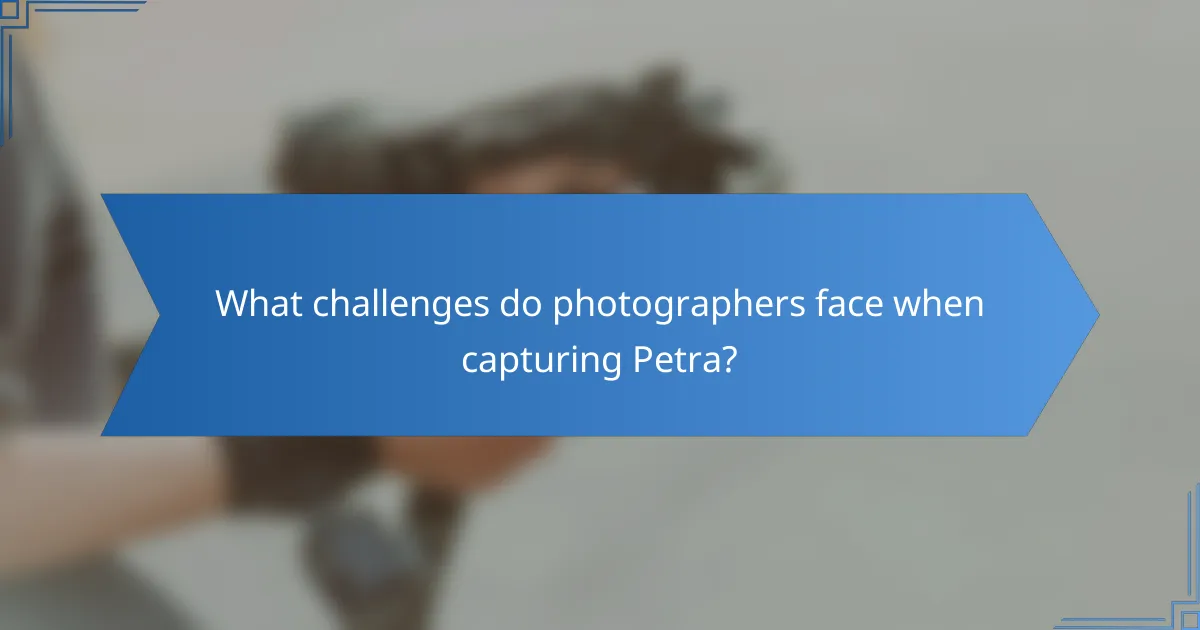
What challenges do photographers face when capturing Petra?
Photographers face numerous challenges when capturing Petra, including lighting conditions, accessibility, and the preservation of ancient structures. Harsh sunlight can create stark shadows, complicating exposure settings. The site’s rugged terrain may restrict movement and angles, while the need to respect and protect the archaeological integrity of the site limits certain photographic techniques. Additionally, the presence of tourists can disrupt compositions, necessitating patience and timing for optimal shots.
How can weather conditions affect photography in Petra?
Weather conditions significantly influence photography in Petra by affecting light quality, visibility, and the overall atmosphere.
Bright sunlight can create harsh shadows and overexposure, making details of the ancient architecture difficult to capture. Conversely, overcast days provide soft, diffused light that enhances textures and colors, revealing the beauty of Nabatean structures.
Dust storms can obscure visibility and create a unique, moody atmosphere, but they also hinder photographic clarity. Rain is rare in Petra, yet when it occurs, it can enrich the landscape, making colors more vibrant and adding reflections to surfaces.
Photographers should consider the time of day as well; golden hour, shortly after sunrise or before sunset, offers the best lighting conditions, casting warm tones on the rock formations and enhancing the visual appeal of the site.
What ethical considerations should photographers keep in mind while documenting cultural heritage?
Photographers documenting cultural heritage must prioritize respect for the community and its traditions. They should seek permission from local authorities and individuals before capturing images. Cultural sensitivity is crucial; understanding the significance of the site and the people enhances the authenticity of the documentation.
In addition, photographers should avoid exploiting cultural symbols for commercial gain. They must also consider the potential impact of their work on the community’s perception and heritage. Ethical storytelling can foster appreciation and awareness rather than perpetuating stereotypes or misrepresentations.
Finally, transparency about the purpose of photography and how images will be used is essential. This builds trust and encourages collaboration with local communities. By adhering to these ethical considerations, photographers can contribute positively to the preservation and representation of cultural heritage.
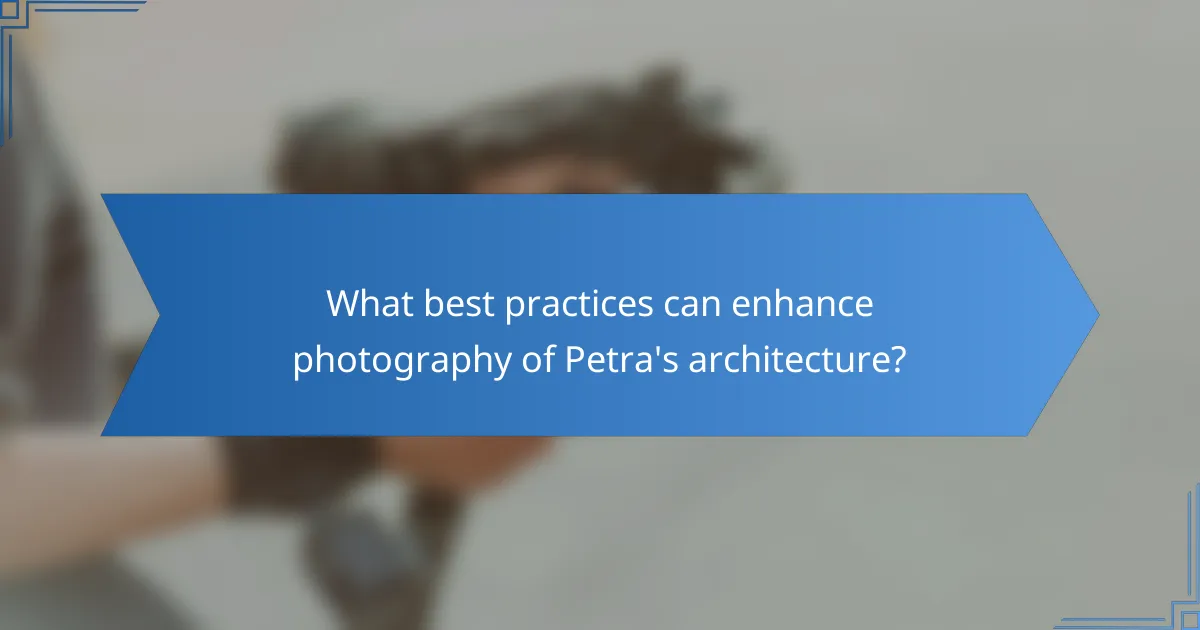
What best practices can enhance photography of Petra’s architecture?
To enhance photography of Petra’s architecture, focus on optimal lighting, composition, and historical context. Early morning or late afternoon provides soft light, highlighting the intricate details of Nabatean structures. Use leading lines and symmetry to create compelling compositions. Incorporating local culture and stories adds depth to the images, enriching their narrative.
How can photographers prepare for a successful shoot in Petra?
Photographers can prepare for a successful shoot in Petra by planning their visit during optimal lighting conditions and understanding the site’s layout. Arrive early to capture the sunrise illuminating the ancient rock-cut architecture. Research the Nabatean culture to enrich your storytelling through imagery. Bring necessary gear, including wide-angle lenses for expansive shots and tripod for stability. Familiarize yourself with local regulations to respect the site and its preservation efforts.
What post-processing techniques can improve images of Petra’s structures?
Post-processing techniques such as HDR imaging, sharpening, and color correction can enhance images of Petra’s structures. HDR imaging captures a wider dynamic range, revealing intricate details in shadows and highlights. Sharpening techniques improve clarity and definition, making architectural features more pronounced. Color correction can adjust tones to reflect the unique hues of Petra’s sandstone, enhancing the visual appeal of photographs.